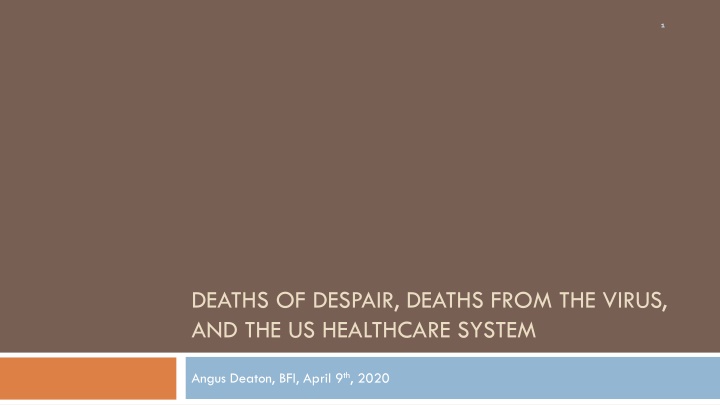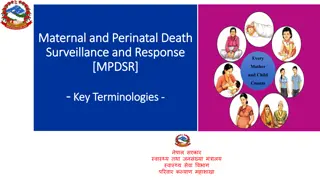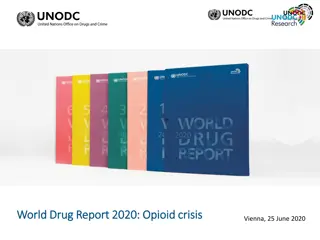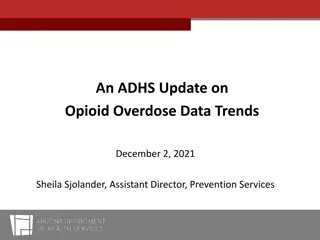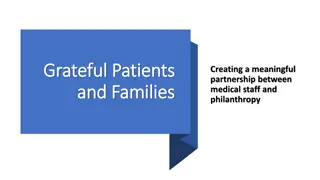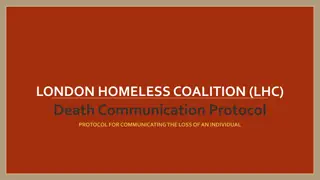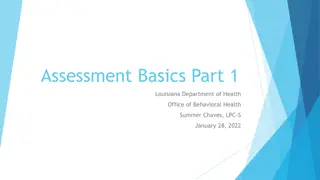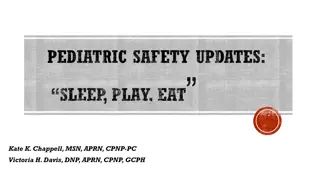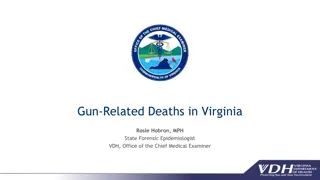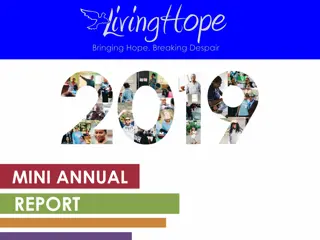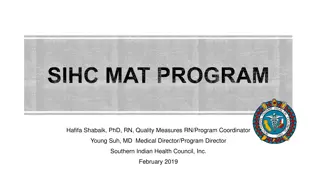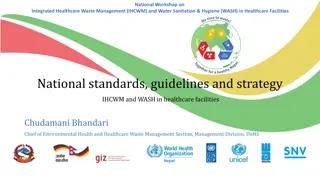Deaths of Despair: Impact on US Healthcare System
Deaths of despair, including suicides, drug overdoses, and alcoholic liver diseases, have been on the rise particularly among Americans without a four-year college degree. This trend is linked to a faltering labor market, globalization, automation, and the oppressive healthcare system in the US. The question arises whether the current economic crisis will exacerbate these deaths further. Analyses have shown that while suicides may increase during economic downturns, overall mortality rates tend to decline. The evidence suggests a complex interplay of factors influencing mortality trends in different economic contexts.
Download Presentation

Please find below an Image/Link to download the presentation.
The content on the website is provided AS IS for your information and personal use only. It may not be sold, licensed, or shared on other websites without obtaining consent from the author.If you encounter any issues during the download, it is possible that the publisher has removed the file from their server.
You are allowed to download the files provided on this website for personal or commercial use, subject to the condition that they are used lawfully. All files are the property of their respective owners.
The content on the website is provided AS IS for your information and personal use only. It may not be sold, licensed, or shared on other websites without obtaining consent from the author.
E N D
Presentation Transcript
1 DEATHS OF DESPAIR, DEATHS FROM THE VIRUS, AND THE US HEALTHCARE SYSTEM Angus Deaton, BFI, April 9th, 2020
Princeton University Press March 17, 2020! Amazon is slow. Support your local independent seller. #assa2020
Background 3 Our book is about Deaths of despair Suicides, drug overdoses, and alcoholic liver diseases 158,000 in 2018 65, 000 in 1995 The increase is almost exclusively among Americans without a four year college degree Both men and women Until recently, predominantly white We trace it back to a faltering labor market for less-educated workers Fewer jobs Lower earnings Familiar causes: globalization and automation Less familiar: the rising costs of an absurd and oppressive healthcare system
Analogy with deaths from coronavirus? 4 The economy has been deliberately crashed: many job losses Likely disproportionately among the less educated Will the crashing of the economy cause an increase in deaths of despair? Perhaps worse than the disease itself? President Donald Trump WE CANNOT LET THE CURE BE WORSE THAN THE PROBLEM ITSELF You're going to lose more people by putting a country into a massive recession or depression, You re going to lose people. You re going to have suicides by the thousands. Suicides maybe, but overall mortality is likely to decline, not increase Many papers, many places, many times find that all-cause mortality falls in recessions Although suicides do increase
Evidence and arguments 5 Deaths of despair are a slow disintegration of working-class lives Not affected by the business-cycle DoD rose before the financial crisis, during the financial crisis and after the financial crisis More generally all-cause mortality rates have fallen In Greece and Spain in financial crisis In Great Depression, mortality rates local record lows Why? Accidents of all sorts are low: highway, construction etc. (Seeing this in NYC now) Alcohol consumption goes down, esp. binge drinking Pollution down, important for infant mortality Elder care in the US, low wage workers can earn more elsewhere in the boom Suicides go up, but are only 2 percent of total deaths
Where is the Great Recession? 6 Those without a BA were a constant proportion ( ~67%) of this population over this period
Maybe this recession is different? 7 Low wage workers may not flock to work in elder care homes now Suicide rates are higher in more isolated places: Rocky Mountain suicide belt Social isolation may be like this Lots of stories of domestic abuse: murders? BUT suicide rates typically lower in wartime Social solidarity Some leaders may be able to forge solidarity now The Queen
Healthcare industry 8 Background from book
Uniquely expensive in the US 9 18 percent of GDP v next highest is 12 in Switzerland, with four years more LE Who pays? About a quarter by employers for employees About a quarter by individuals directly About half by Federal and State governments, most of last for Medicaid Employer plans in 2019 $20k for family $10k for individual For low-wage workers, this is not feasible: like a poll-tax Large firms no longer employ janitors, drivers, call-center operators, food service workers, security Outsourced or gig workers: much worse jobs State governments cut state universities to pay for Medicaid; share 20% to 30% in a decade Until COVID, future Federal deficits are almost entirely for healthcare
Absurd and oppressive monopolies 10 Adam Smith: here the protection that government gives to maintain the wealth of the industry Five lobbyists for each member of Congress Opioid manufacturers targeted communities of despair And made billions from addiction and overdoses While Congress protected them by changing laws, and muzzling DEA J & J subsidiary growing opium in Tasmania No other country allows this Surprise medical bills, prescription drug benefits, lack of CBA for procedures, drugs and devices, no price controls, automatic Medicare payment for drugs approved by FDA, industry finances FDA, and influences trials and approvals Hospitals merge with little attention from anti-trust regulators Monopoly in local markets, monopsony against nurses
Healthcare and covid19 11 Two possibilities: healthcare the HERO, healthcare the VILLAIN Doctors and nurses are seen as those who saved us Pharma will come up with a vaccine and drugs, and make them widely available (Lobbyists fought affordability provision in coronavirus bill: $3.1 bn for development of drugs and vaccines) Hospitals will co-ordinate, share equipment, beds, and staff: happening already in NY Testing free, copays and deductibles waived by insurers Deaths relatively small, and full recovery for others Opposite of above Drugs expensive and rationed by price: pharma overreaches No vaccine for many years Many thousands left with very large bills that they cannot pay, that destroy credit for rest of life Large surprise medical bills, even when insurers waive copays and deductibles Anger penetrates the protective cordon in Washington and we get reform
COVID19 and inequality 12 Inequality of income: unequal financial burden Inequality of health outcomes: different groups die more or get sick more
Clear immediate effect 13 Less-educated Americans are either: Essential workers, which puts their lives at risk (Subway, grocery stores, etc.) Non-essential, which puts their livelihood at risk (depending on emergency transfer programs) Either way, health inequality by education, and income inequality (by education or just income) likely to increase Already indications that blacks and Hispanics disproportionately affected Excess mortality rates seem to be roughly proportional to existing mortality rates Men twice women, pre-existing conditions raise mortality Morbidity higher among the less-educated Social distancing is harder for poorer people Close to impossible for poor people in India, Africa, etc High rates of baseline morbidity Lockdowns likely to remove livelihoods without improving health, esp with poor healthcare systems
Less clear long run 14 Globalization is likely to be in retreat (already was) We ve been getting higher incomes by incurring risks Some off-shore jobs will return More diverse sources of key materials: medicines Lower income inequality and lower average incomes Healthcare reform to something else (many possible models) Remove burden on less-educated jobs and increase supply of low-education jobs Reduce earnings of industry professionals in pharma, hospital management, device manufacturers, and physicians Both together could substantially reduce income inequality Reduce deaths of despair among less-educated Americans
All-cause mortality, men and women ages 45-54 1400 1200 deaths per 100,000 1000 US White 800 600 400 1900 1920 1940 1960 1980 2000 year
Drug, alcohol and suicide mortality rates, white non-Hispanics
US Deaths of despair Alcoholic liver disease: in every US state, age-adjusted mortality rates rose for white non-Hispanic prime-aged adults (ages 25-64) from (1999-2000) to (2017-2018) Suicide: in every state, suicide rates rose for prime-aged WNH from (1999-2000) to (2017-2018) Accidental or intent undetermined drug poisoning: mortality rates increased in every state from (1999-2000) to (2017-2018) but classifying the underlying drugs is shooting at a moving target -- Prescription opioids, heroin, fentanyl
Wages and labor market attachment, men ages 25-54, less than a four-year degree 24
Life expectancy and health expenditure per capita ($2010 international dollars) 1970-2015
Life expectancy and health expenditure per capita ($2010 international dollars) 1970-2015
Life expectancy and health expenditure per capita ($2010 international dollars) 1970-2015
Life expectancy and health expenditure per capita ($2010 international dollars) 1970-2015
Life expectancy and health expenditure per capita ($2010 international dollars) 1970-2015
Life expectancy and health expenditure per capita ($2010 international dollars) 1970-2015
Life expectancy and health expenditure per capita ($2010 international dollars) 1970-2015
Life expectancy and health expenditure per capita ($2010 international dollars) 1970-2015
The trillion dollar protection racket 33 17.8 percent of US GDP in 2018 Switzerland is next highest at 12.4 percent Swiss lives are five years longer than American lives Difference in spending is 5.4 percent, or more than a trillion dollars a year More than $8,300 for each US household This is just the waste Americans pay more for most health services and products, and use a lot more of low value high cost procedures, drugs, and machines
We argue that, in many respects, what has happened to white working class Americans mirrors what happened to African Americans beginning in the 1960s, and can be seen as another chapter in the saga of American labor. Many of the same arguments made about black culture, going back to the Moynihan Report [ at the center of the tangle of pathology is the weakness of the family structure ] are being made today about the white working class culture Charles Murray: white males of the 2000s were less industrious than they had been 20, 30 or 50 years ago the decay in industriousness occurred overwhelmingly in [white working-class] Fishtown
